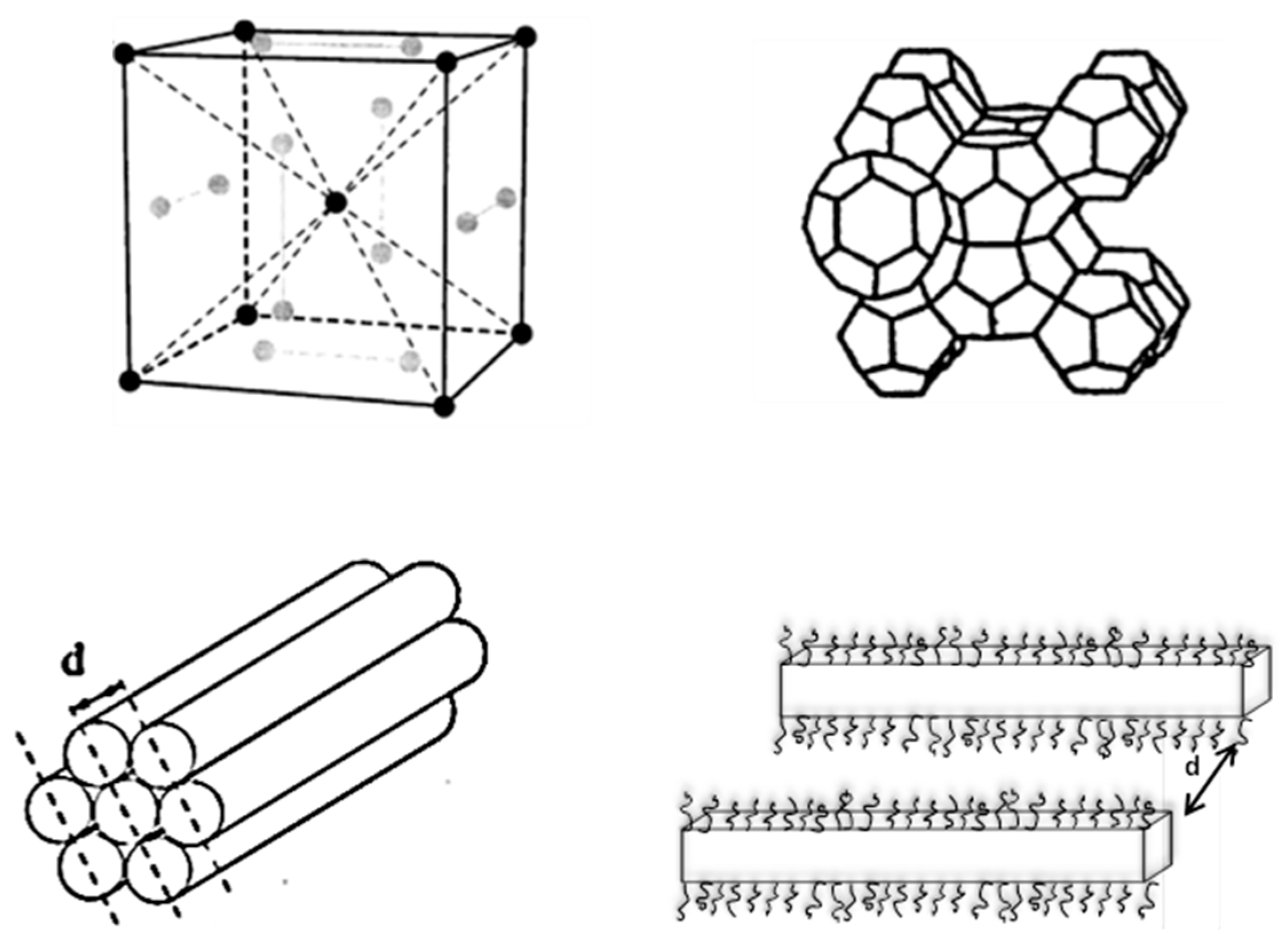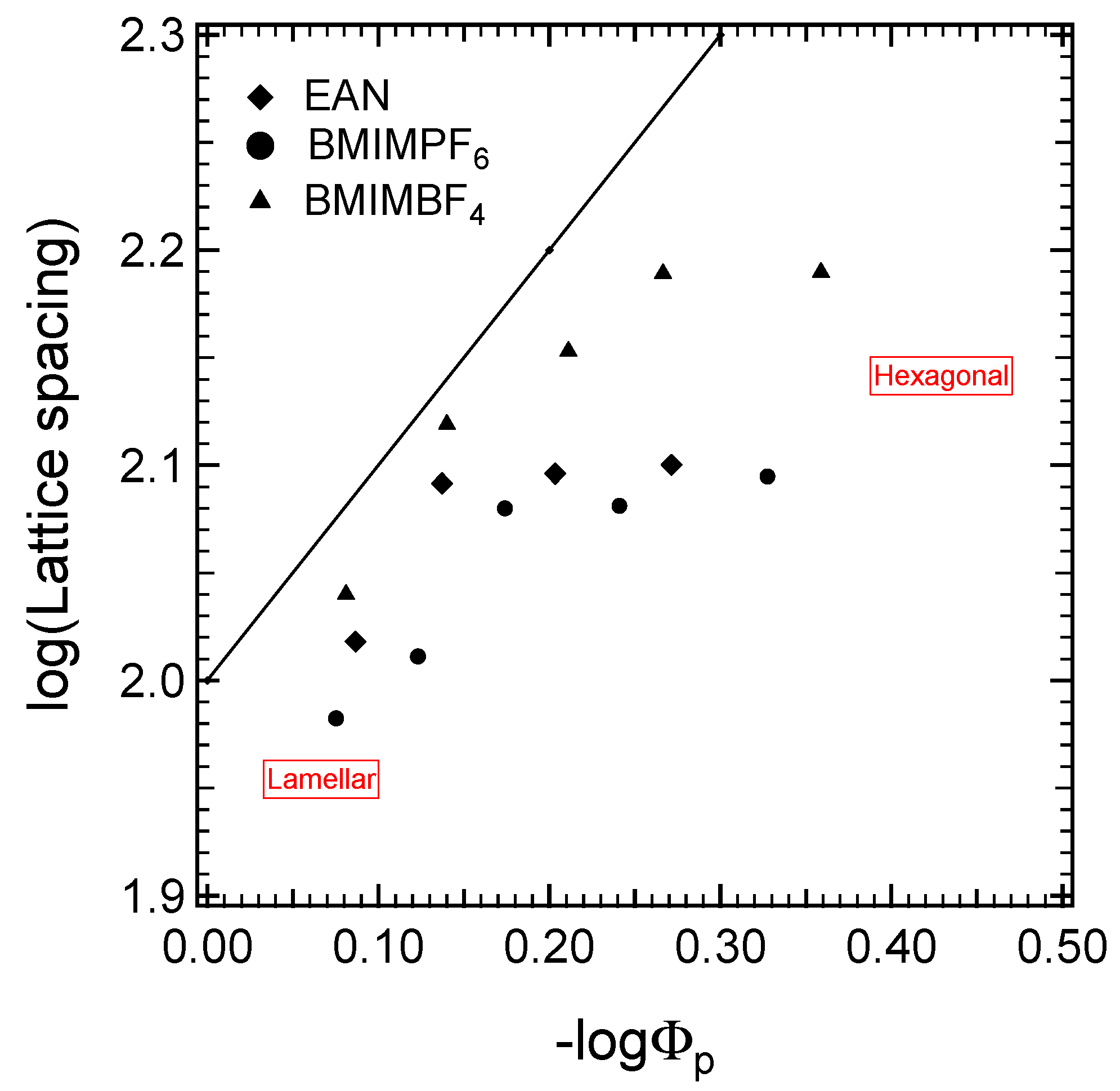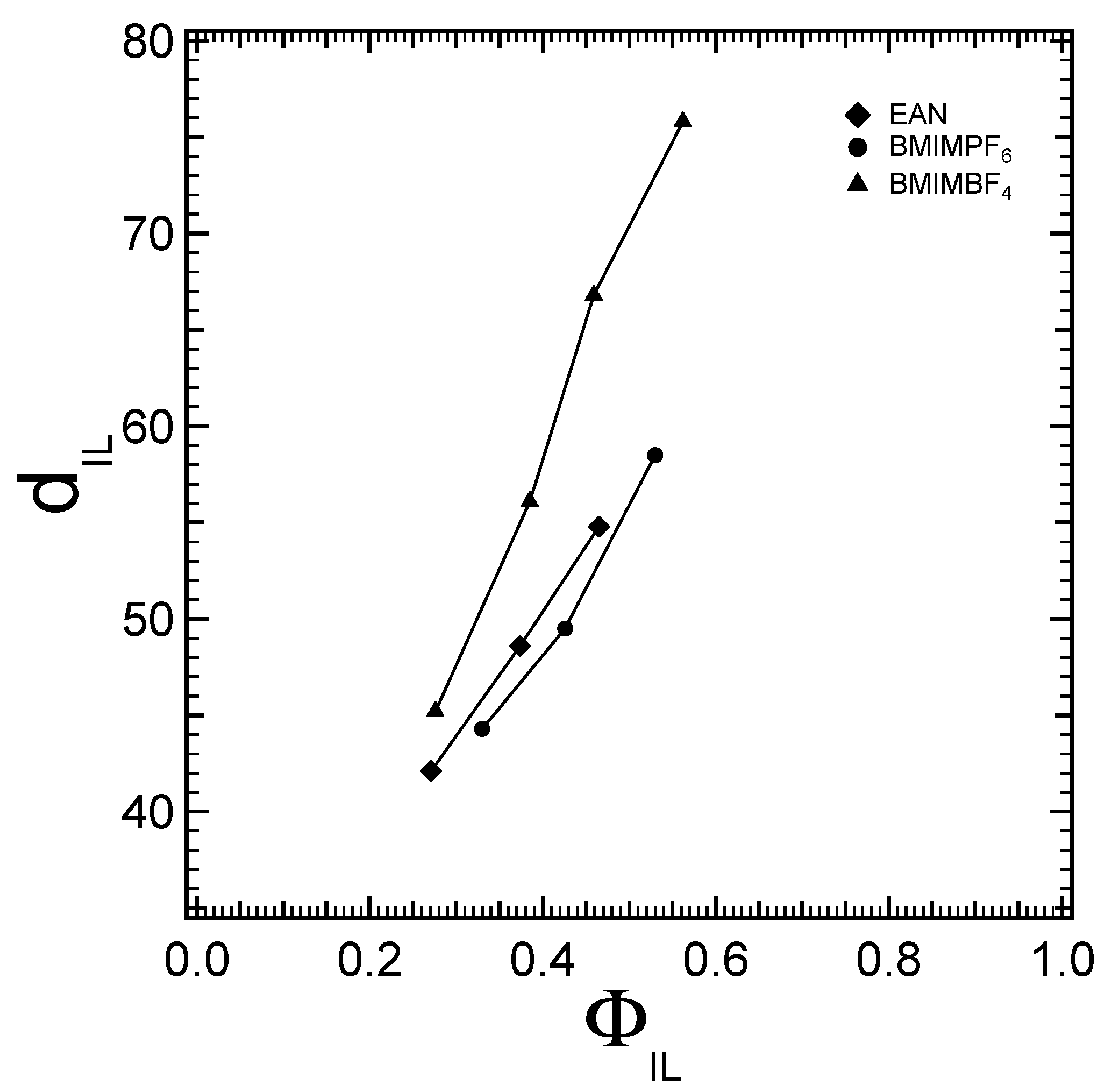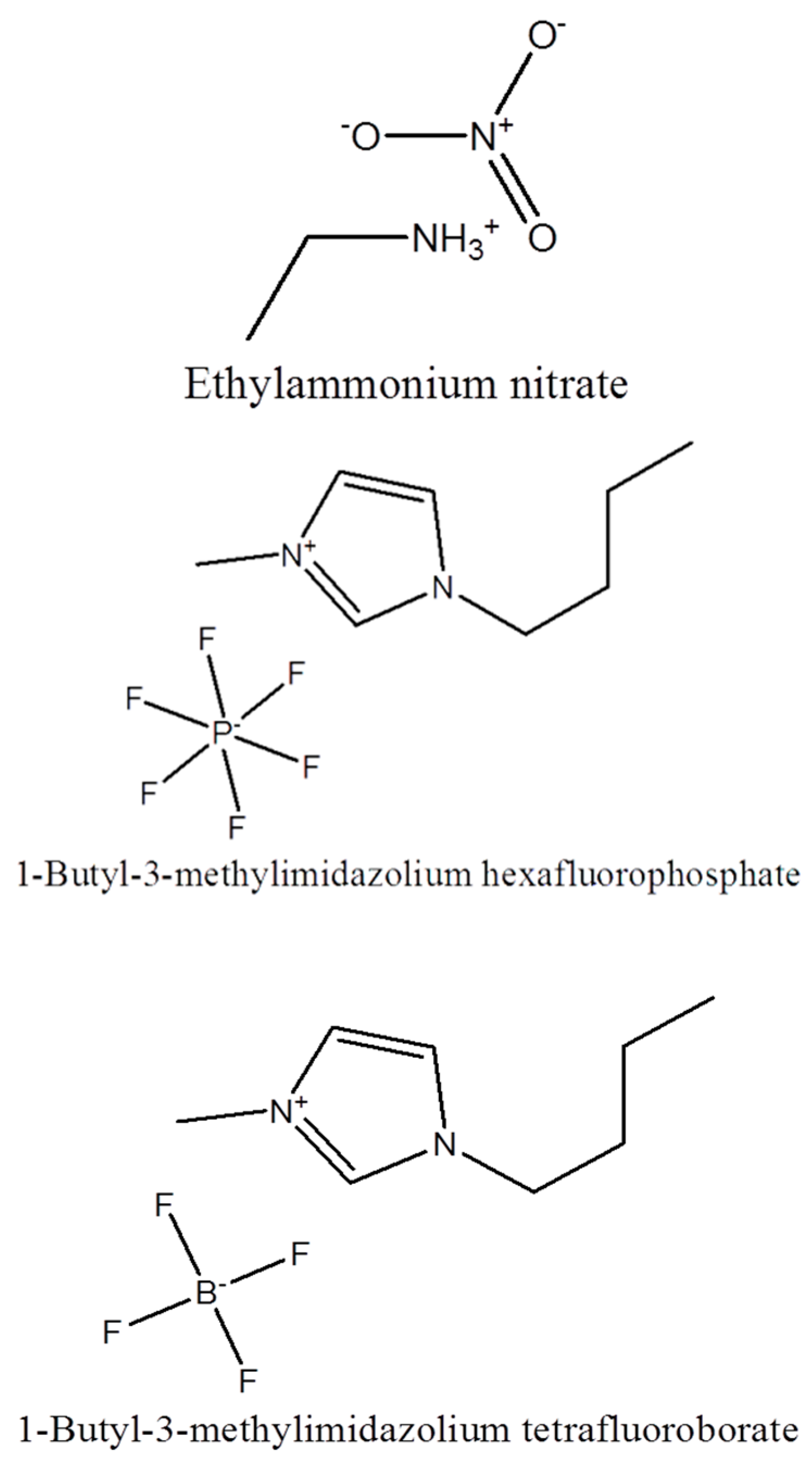Phase Behavior and Structure of Poloxamer Block Copolymers in Protic and Aprotic Ionic Liquids
Abstract
:1. Introduction
2. Results and Discussion
2.1. Phase Behavior of Binary EO37PO58EO37 + Ionic Liquid Systems
2.2. Structure in the Binary EO37PO58EO37 + Ionic Liquid Systems
2.3. Characteristic Scale Lengths of Lyotropic Liquid Crystalline Structures
2.4. Molecular Interactions Underlying Ionic Liquid Solvent Selectivity
2.5. Comparison of Phase Behavior and Structure in Water or Formamide
2.6. Comparison with Other Block Copolymer + Ionic Liquid Binary Systems
3. Materials and Methods
4. Conclusions
Author Contributions
Funding
Institutional Review Board Statement
Informed Consent Statement
Data Availability Statement
Acknowledgments
Conflicts of Interest
References
- Evans, D.F.; Wennestrom, H. The Colloidal Domain, 2nd ed.; Wiley-VCH: Weinheim, Germany, 1999. [Google Scholar]
- Hadjichristidis, N.; Pispas, S.; Floudas, G. Block Copolymers: Synthetic Strategies, Physical Properties, and Applications; Wiley: Hoboken, NJ, USA, 2003. [Google Scholar]
- Alexandridis, P.; Spontak, R.J. Solvent-regulated ordering in block copolymers. Curr. Opin. Colloid Interface Sci. 1999, 4, 130–139. [Google Scholar] [CrossRef]
- Alexandridis, P.; Zhou, D.L.; Khan, A. Lyotropic liquid crystallinity in amphiphilic block copolymers: Temperature effects on phase behavior and structure for poly(ethylene oxide)-b-poly(propylene oxide)-b-poly(ethylene oxide) copolymers of different composition. Langmuir 1996, 12, 2690–2700. [Google Scholar] [CrossRef]
- Spontak, R.J.; Alexandridis, P. Advances in self-ordering macromolecules and nanostructure design. Curr. Opin. Colloid Interface Sci. 1999, 4, 140–146. [Google Scholar] [CrossRef]
- Lodge, T.P.; Pudil, B.; Hanley, K.J. The full phase behavior for block copolymers in solvents of varying selectivity. Macromolecules 2002, 35, 4707–4717. [Google Scholar] [CrossRef]
- Zipfel, J.; Berghausen, J.; Schmidt, G.; Lindner, P.; Alexandridis, P.; Tsianou, M.; Richtering, W. Shear induced structures in lamellar phases of amphiphilic block copolymers. Phys. Chem. Chem. Phys. 1999, 1, 3905–3910. [Google Scholar] [CrossRef]
- Yang, L.; Alexandridis, P. Polyoxyalkylene block copolymers in formamide-water mixed solvents: Micelle formation and structure studied by small-angle neutron scattering. Langmuir 2000, 16, 4819–4829. [Google Scholar] [CrossRef]
- Alexandridis, P.; Yang, L. Micellization of polyoxyalkylene block copolymers in formamide. Macromolecules 2000, 33, 3382–3391. [Google Scholar] [CrossRef]
- Ivanova, R.; Lindman, B.; Alexandridis, P. Effect of pharmaceutically acceptable glycols on the stability of the liquid crystalline gels formed by Poloxamer 407 in water. J. Colloid Interface Sci. 2002, 252, 226–235. [Google Scholar] [CrossRef]
- Gronheid, R.; Rincon Delgadillo, P.; Singh, A.; Younkin, T.R.; Sayan, S.; Chan, B.T.B.; Van Look, L.; Bekaert, J.; Pollentir, I.; Nealey, P.F. Readying directed self-assembly for patterning in semi-conductor manufacturing. J. Photopolym. Sci. Technol. 2013, 26, 779–791. [Google Scholar] [CrossRef]
- Karanikolos, G.N.; Alexandridis, P.; Mallory, R.; Petrou, A.; Mountziaris, T.J. Templated synthesis of ZnSe nanostructures using lyotropic liquid crystals. Nanotechnology 2005, 16, 2372–2380. [Google Scholar] [CrossRef]
- Cabral, H.; Miyata, K.; Osada, K.; Kataoka, K. Block copolymer micelles in nanomedicine applications. Chem. Rev. 2018, 118, 6844–6892. [Google Scholar] [CrossRef] [PubMed]
- Bodratti, A.M.; Alexandridis, P. Formulation of Poloxamers for drug delivery. J. Funct. Biomater. 2018, 9, 11. [Google Scholar] [CrossRef] [PubMed]
- He, Z.; Alexandridis, P. Nanoparticles in ionic liquids: Interactions and organization. Phys. Chem. Chem. Phys. 2015, 17, 18238–18261. [Google Scholar] [CrossRef] [PubMed]
- Hayes, R.; Warr, G.G.; Atkin, R. Structure and nanostructure in ionic liquids. Chem. Rev. 2015, 115, 6357–6426. [Google Scholar] [CrossRef] [PubMed]
- Gutowski, K.E. Industrial uses and applications of ionic liquids. Phys. Sci. Rev. 2018, 3, 20170191. [Google Scholar]
- Singh, S.K.; Savoy, A.W. Ionic liquids synthesis and applications: An overview. J. Mol. Liq. 2020, 297, 112038. [Google Scholar] [CrossRef]
- Wang, Y.L.; Li, B.; Sarman, S.; Mocci, F.; Lu, Z.Y.; Yuan, J.Y.; Laaksonen, A.; Fayer, M.D. Microstructural and dynamical heterogeneities in ionic liquids. Chem. Rev. 2020, 120, 5798–5877. [Google Scholar] [CrossRef]
- Greaves, T.L.; Drummond, C.J. Solvent nanostructure, the solvophobic effect and amphiphile self-assembly in ionic liquids. Chem. Soc. Rev. 2013, 42, 1096–1120. [Google Scholar] [CrossRef]
- Zhai, J.; Sarkar, S.; Tran, N.; Pandiancherri, S.; Greaves, T.L.; Drummond, C.J. Tuning nanostructured lyotropic liquid crystalline mesophases in lipid nanoparticles with protic ionic liquids. J. Phys. Chem. Lett. 2021, 12, 399–404. [Google Scholar] [CrossRef]
- He, Z.; Ma, Y.; Alexandridis, P. Comparison of ionic liquid and salt effects on the thermodynamics of amphiphile micellization in water. Colloids Surf. A Physicochem. Eng. Asp. 2018, 559, 159–168. [Google Scholar] [CrossRef]
- Zhang, Y.; He, Z.; Alexandridis, P.; Tsianou, M. Polymeric surfactant micelle structure modulated by ionic liquids. J. Mol. Liq. 2022, 346, 118195. [Google Scholar] [CrossRef]
- Yang, G.; Song, Y.; Wang, Q.; Zhang, L.; Deng, L. Review of ionic liquids containing, polymer/inorganic hybrid electrolytes for lithium metal batteries. Mater. Des. 2020, 190, 108563. [Google Scholar] [CrossRef]
- He, Z.; Alexandridis, P. Ionic liquid and nanoparticle hybrid systems: Emerging applications. Adv. Colloid Interface Sci. 2017, 244, 54–70. [Google Scholar] [CrossRef] [PubMed]
- Lin, J.-C.; Liatsis, P.; Alexandridis, P. Flexible and stretchable electrically conductive polymer materials for physical sensing applications. Polym. Rev. 2023, 63, 67–126. [Google Scholar] [CrossRef]
- Lam, B.; Wei, M.; Zhu, L.; Luo, S.; Guo, R.; Morisato, A.; Alexandridis, P.; Lin, H. Cellulose triacetate doped with ionic liquids for membrane gas separation. Polymer 2016, 89, 1–11. [Google Scholar] [CrossRef]
- Ventura, S.P.M.; e Silva, F.A.; Quental, M.V.; Mondal, D.; Freire, M.G.; Coutinho, J.A.P. Ionic-liquid-mediated extraction and separation processes for bioactive compounds: Past, present, and future trends. Chem. Rev. 2017, 117, 6984–7052. [Google Scholar] [CrossRef]
- Sivapragasam, M.; Moniruzzaman, M.; Goto, M. Recent advances in exploiting ionic liquids for biomolecules: Solubility, stability and applications. Biotechnol. J. 2016, 11, 1000–1013. [Google Scholar] [CrossRef]
- Alexandridis, P.; Ghasemi, M.; Furlani, E.P.; Tsianou, M. Solvent processing of cellulose for effective bioresource utilization. Curr. Opin. Green Sustain. Chem. 2018, 14, 40–52. [Google Scholar] [CrossRef]
- Karimi, B.; Tavakolian, M.; Akbari, M.; Mansouri, F. Ionic liquids in asymmetric synthesis: An overall view from reaction media to supported ionic liquid catalysis. ChemCatChem 2018, 10, 3173. [Google Scholar] [CrossRef]
- Adawiyah, N.; Moniruzzaman, M.; Hawatulaila, S.; Goto, M. Ionic liquids as a potential tool for drug delivery systems. MedChemComm 2016, 7, 1881–1897. [Google Scholar] [CrossRef]
- Nancarrow, P.; Mohammed, H. Ionic liquids in space technology—Current and future trends. ChemBioEng Rev. 2017, 4, 106–119. [Google Scholar] [CrossRef]
- Zhang, D.; Li, L.; Wu, X.; Wang, J.; Li, Q.; Pan, K.; He, J. Research progress and application of PEO-based solid state polymer composite electrolytes. Front. Energy Res. 2021, 9, 726738. [Google Scholar] [CrossRef]
- Wang, W.; Alexandridis, P. Composite polymer electrolytes: Nanoparticles impact structure and properties. Polymers 2016, 8, 387. [Google Scholar] [CrossRef] [PubMed]
- Alexandridis, P.; Hatton, T.A. Poly(ethylene oxide)-poly(propylene oxide)-poly(ethylene oxide) block-copolymer surfactants in aqueous-solutions and at interfaces—Thermodynamics, structure, dynamics, and modeling. Colloids Surf. A 1995, 96, 1–46. [Google Scholar] [CrossRef]
- Alexandridis, P.; Olsson, U.; Lindman, B. A record nine different phases (four cubic, two hexagonal, and one lamellar lyotropic liquid crystalline and two micellar solutions) in a ternary isothermal system of an amphiphilic block copolymer and selective solvents (water and oil). Langmuir 1998, 14, 2627–2638. [Google Scholar] [CrossRef]
- Evans, D.F. Self-organization of amphiphiles. Langmuir 1988, 4, 3–12. [Google Scholar] [CrossRef]
- Xie, R.; López-Barrón, C.R.; Wagner, N.J. Self-assembly of block copolymers in ionic liquids. ACS Symp. Ser. 2017, 1250, 83–142. [Google Scholar]
- Kumar, K.; Umapathi, R.; Venkatesu, P. Ionic liquids mediated micellization of pluronic copolymers: Aggregation behavior of amphiphilic triblock copolymers. J. Phys. Chem. B 2023, 127, 2107–2120. [Google Scholar] [CrossRef]
- Aerov, A.A.; Khokhlov, A.R.; Potemkin, I.I. Why ionic liquids can possess extra solvent power. J. Phys. Chem. B 2006, 110, 16205–16207. [Google Scholar] [CrossRef]
- Shimizu, K.; Gomes, M.F.C.; Padua, A.A.H.; Rebelo, L.P.N.; Lopes, J.N.C. Three commentaries on the nano-segregated structure of ionic liquids. J. Mol. Struc.-Theochem. 2010, 946, 70–76. [Google Scholar] [CrossRef]
- Rebelo, L.P.N.; Lopes, J.N.C.; Esperanca, J.M.S.S.; Guedes, H.J.R.; Lachwa, J.; Najdanovic-Visak, V.; Visak, Z.P. Accounting for the unique, doubly dual nature of ionic liquids from a molecular thermodynamic, and modeling standpoint. Acc. Chem. Res. 2007, 40, 1114–1121. [Google Scholar] [CrossRef] [PubMed]
- Padua, A.A.H.; Gomes, M.F.; Lopes, J.N.A.C. Molecular solutes in ionic liquids: A structural, perspective. Acc. Chem. Res. 2007, 40, 1087–1096. [Google Scholar] [CrossRef] [PubMed]
- Greaves, T.L.; Drummond, C.J. Ionic liquids as amphiphile self-assembly media. Chem. Soc. Rev. 2008, 37, 1709–1726. [Google Scholar] [CrossRef]
- Greaves, T.L.; Drummond, C.J. Protic ionic liquids: Properties and applications. Chem. Rev. 2008, 108, 206–237. [Google Scholar] [CrossRef] [PubMed]
- Armand, M.; Endres, F.; MacFarlane, D.R.; Ohno, H.; Scrosati, B. Ionic-liquid materials for the electrochemical challenges of the future. Nat. Mater. 2009, 8, 621–629. [Google Scholar] [CrossRef]
- Fumino, K.; Wulf, A.; Ludwig, R. Hydrogen bonding in protic ionic liquids: Reminiscent of water. Angew. Chem. Int. Ed. 2009, 48, 3184–3186. [Google Scholar] [CrossRef] [PubMed]
- Angell, C.A.; Byrne, N.; Belieres, J.P. Parallel developments in aprotic and protic ionic liquids: Physical chemistry and applications. Acc. Chem. Res. 2007, 40, 1228–1236. [Google Scholar] [CrossRef]
- Angell, C.A.; Ansari, Y.; Zhao, Z. Ionic liquids: Past, present and future. Faraday Discuss 2012, 154, 9–27; discussion 81–96, 465–467. [Google Scholar] [CrossRef]
- Triolo, A.; Mandanici, A.; Russina, O.; Rodriguez-Mora, V.; Cutroni, M.; Hardacre, C.; Nieuwenhuyzen, M.; Bleif, H.J.; Keller, L.; Ramos, M.A. Thermodynamics, structure, and dynamics in room temperature ionic liquids: The case of 1-butyl-3-methyl imidazolium hexafluorophosphate ([bmim][PF6]). J. Phys. Chem. B 2006, 110, 21357–21364. [Google Scholar] [CrossRef]
- Tokuda, H.; Tsuzuki, S.; Susan, M.A.B.H.; Hayamizu, K.; Watanabe, M. How ionic are room-temperature ionic liquids? An indicator of the physicochemical properties. J. Phys. Chem. B 2006, 110, 19593–19600. [Google Scholar] [CrossRef] [PubMed]
- Forsyth, M.; Porcarelli, L.; Wang, X.; Goujon, N.; Mecerreyes, D. Innovative Electrolytes Based on Ionic Liquids and Polymers for Next-Generation Solid-State Batteries. Acc. Chem. Res. 2019, 52, 686–694. [Google Scholar] [CrossRef] [PubMed]
- Glynos, E.; Pantazidis, C.; Sakellariou, G. Designing all-polymer nanostructured solid electrolytes: Advances and prospects. ACS Omega 2020, 5, 2531–2540. [Google Scholar] [CrossRef] [PubMed]
- White, B.T.; Long, T.E. Advances in polymeric materials for electromechanical devices. Macromol. Rapid Commun. 2019, 40, e1800521. [Google Scholar] [CrossRef]
- Angelini, G.; Gasbarri, C. Polymeric aggregates in ionic liquids: The green future of the delivery systems. Curr. Drug Targets 2015, 16, 1606–1611. [Google Scholar] [CrossRef] [PubMed]
- Zeng, S.; Zhang, X.; Bai, L.; Zhang, X.; Wang, H.; Wang, J.; Bao, D.; Li, M.; Liu, X.; Zhang, S. Ionic-liquid-based CO2 capture systems: Structure, interaction and process. Chem. Rev. 2017, 117, 9625–9673. [Google Scholar] [CrossRef]
- Lodge, T.P.; Ueki, T. Mechanically tunable, readily processable ion gels by self-assembly of block copolymers in ionic liquids. Acc. Chem. Res. 2016, 49, 2107–2114. [Google Scholar] [CrossRef]
- Alexandridis, P. Structural polymorphism of poly(ethylene oxide)-poly(propylene oxide) block copolymers in nonaqueous polar solvents. Macromolecules 1998, 31, 6935–6942. [Google Scholar] [CrossRef]
- Seddon, J.M.; Templer, R.H. Cubic phases of self-assembled amphiphilic aggregates. Philos. Trans. R. Soc. A 1993, 344, 377–401. [Google Scholar]
- Alexandridis, P.; Andersson, K. Effect of solvent quality on reverse micelle formation and water solubilization by poly(ethylene oxide) poly(propylene oxide) and poly(ethylene oxide) poly(butylene oxide) block copolymers in xylene. J. Colloid Interface Sci. 1997, 194, 166–173. [Google Scholar] [CrossRef]
- Svensson, B.; Olsson, U.; Alexandridis, P.; Mortensen, K. A SANS Investigation of reverse (water-in-oil) micelles of amphiphilic block copolymers. Macromolecules 1999, 32, 6725–6733. [Google Scholar] [CrossRef]
- Miranda, D.F.; Russell, T.P.; Watkins, J.J. Ordering in mixtures of a triblock copolymer with a room temperature ionic liquid. Macromolecules 2010, 43, 10528–10535. [Google Scholar] [CrossRef]
- Ivanova, R.; Lindman, B.; Alexandridis, P. Effect of glycols on the self-assembly of amphiphilic block copolymers in water. 1. Phase diagrams and structure identification. Langmuir 2000, 16, 3660–3675. [Google Scholar] [CrossRef]
- Charvolin, J.; Sadoc, J.F. Periodic-systems of frustrated fluid films and micellar cubic structures in liquid-crystals. J. Phys. 1988, 49, 521–526. [Google Scholar] [CrossRef]
- Fontell, K. Cubic phases in surfactant and surfactant-like lipid systems. Colloid Polym. Sci. 1990, 268, 264–285. [Google Scholar] [CrossRef]
- Seddon, J.M.; Robins, J.; Gulik-Krzywicki, T.; Delacroix, H. Inverse micellar phases of phospholipids and glycolipids. Phys. Chem. Chem. Phys. 2000, 2, 4485–4493. [Google Scholar] [CrossRef]
- Svensson, B.; Alexandridis, P.; Olsson, U. Self-Assembly of a Poly(ethylene oxide)/Poly(propylene oxide) Block Copolymer (Pluronic P104, (EO)27(PO)61(EO)27) in the Presence of Water and Xylene. J. Phys. Chem. B 1998, 102, 7541–7548. [Google Scholar] [CrossRef]
- Svensson, B.; Olsson, U.; Alexandridis, P. Self-assembly of block copolymers in selective solvents: Influence of relative block size on phase behavior. Langmuir 2000, 16, 6839–6846. [Google Scholar] [CrossRef]
- Lai, C.J.; Russel, W.B.; Register, R.A. Scaling of domain spacing in concentrated solutions of block copolymers in selective solvents. Macromolecules 2002, 35, 4044–4049. [Google Scholar] [CrossRef]
- Alexandridis, P.; Ivanova, R.; Lindman, B. Effect of glycols on the self-assembly of amphiphilic block copolymers in water. 2. Glycol location in the microstructure. Langmuir 2000, 16, 3676–3689. [Google Scholar] [CrossRef]
- Kennedy, D.F.; Drummond, C.J. Large aggregated ions found in some protic ionic liquids. J. Phys. Chem. B 2009, 113, 5690–5693. [Google Scholar] [CrossRef]
- Werzer, O.; Warr, G.G.; Atkin, R. Conformation of poly(ethylene oxide) dissolved in ethylammonium nitrate. J. Phys. Chem. B 2011, 115, 648–652. [Google Scholar] [CrossRef]
- He, Z.; Alexandridis, P. Micellization thermodynamics of Pluronic P123 (EO20PO70EO20) amphiphilic block copolymer in aqueous ethylammonium nitrate (EAN) solutions. Polymers 2018, 10, 32. [Google Scholar] [CrossRef] [PubMed]
- Atkin, R.; De Fina, L.M.; Kiederling, U.; Warr, G.G. Structure and self assembly of pluronic amphiphiles in ethylammonium nitrate and at the silica surface. J. Phys. Chem. B 2009, 113, 12201–12213. [Google Scholar] [CrossRef] [PubMed]
- Werzer, O.; Warr, G.G.; Atkin, R. Compact poly(ethylene oxide) structures adsorbed at the ethylammonium nitrate-silica interface. Langmuir 2011, 27, 3541–3549. [Google Scholar] [CrossRef]
- Weingaertner, H. Understanding ionic liquids at the molecular level: Facts, problems, and controversies. Angew. Chem. Int. Ed. 2008, 47, 654–670. [Google Scholar] [CrossRef] [PubMed]
- Crowhurst, L.; Mawdsley, P.R.; Perez-Arlandis, J.M.; Salter, P.A.; Welton, T. Solvent-solute interactions in ionic liquids. Phys. Chem. Chem. Phys. 2003, 5, 2790–2794. [Google Scholar] [CrossRef]
- Gao, Y.; Zhang, L.Q.; Wang, Y.; Li, H.R. Probing electron density of h-bonding between cation-anion of imidazolium-based ionic liquids with different anions by vibrational spectroscopy. J. Phys. Chem. B 2010, 114, 2828–2833. [Google Scholar] [CrossRef]
- Jung, H.Y.; Park, M.J. Thermodynamics and phase behavior of acid-tethered block copolymers with ionic liquids. Soft Matter 2016, 13, 250–257. [Google Scholar] [CrossRef]
- Costa, L.T.; Ribeiro, M.C.C. Molecular dynamics simulation of polymer electrolytes based on poly(ethylene oxide) and ionic liquids. I. Structural properties. J. Chem. Phys. 2006, 124, 184902. [Google Scholar] [CrossRef]
- Triolo, A.; Russina, O.; Keiderling, U.; Kohlbrecher, J. Morphology of poly(ethylene oxide) dissolved in a room temperature ionic liquid: A small angle neutron scattering study. J. Phys. Chem. B 2006, 110, 1513–1515. [Google Scholar] [CrossRef]
- Tsuda, R.; Kodama, K.; Ueki, T.; Kokubo, H.; Imabayashi, S.; Watanabe, M. LCST-type liquid-liquid phase separation behaviour of poly(ethylene oxide) derivatives in an ionic liquid. Chem. Commun. 2008, 40, 4939–4941. [Google Scholar] [CrossRef]
- Sharma, S.C.; Atkin, R.; Warr, G.G. The effect of ionic liquid hydrophobicity and solvent miscibility on pluronic amphiphile self-assembly. J. Phys. Chem. B 2013, 117, 14568–14575. [Google Scholar] [CrossRef] [PubMed]
- Sarkar, A.; Trivedi, S.; Pandey, S. Polymer molecular weight-dependent unusual fluorescence probe behavior within 1-butyl-3-methylimidazolium hexafluorophosphate plus poly(ethylene glycol). J. Phys. Chem. B 2009, 113, 7606–7614. [Google Scholar] [CrossRef]
- Considine, R.F.; Drummond, C.J. Long-range force of attraction between solvophobic surfaces in water and organic liquids containing dissolved air. Langmuir 2000, 16, 631–635. [Google Scholar] [CrossRef]
- López-Barrón, C.R.; Li, D.; Wagner, N.J.; Caplan, J.L. Triblock copolymer self-assembly in ionic liquids: Effect of PEO block length on the self-assembly of PEO–PPO–PEO in ethylammonium nitrate. Macromolecules 2014, 47, 7484–7495. [Google Scholar] [CrossRef]
- Pérez-Sánchez, G.; Schaeffer, N.; Lopes, A.M.; Pereira, J.F.B.; Coutinho, J.A.P. Using coarse-grained molecular dynamics to understand the effect of ionic liquids on the aggregation of Pluronic copolymer solutions. Phys. Chem. Chem. Phys. 2021, 23, 5824. [Google Scholar] [CrossRef]
- Zhang, G.; Chen, X.; Zhao, Y.; Ma, F.; Jing, B.; Qiu, H. Lyotropic liquid-crystalline phases formed by Pluronic P123 in ethylammonium nitrate. J. Phys. Chem. B 2008, 112, 6578–6584. [Google Scholar] [CrossRef] [PubMed]
- Wang, L.Y.; Chen, X.; Chai, Y.C.; Hao, J.C.; Sui, Z.M.; Zhuang, W.C.; Sun, Z.W. Lyotropic liquid crystalline phases formed in an ionic liquid. Chem. Commun. 2004, 24, 2840–2841. [Google Scholar] [CrossRef]
- Chen, Z.; Greaves, T.L.; Fong, C.; Caruso, R.A.; Drummond, C.J. Lyotropic liquid crystalline phase behaviour in amphiphile-protic ionic liquid systems. Phys. Chem. Chem. Phys. 2012, 14, 3825–3836. [Google Scholar] [CrossRef]
- Brinkkötter, M.; Geisler, R.; Großkopf, S.; Hellweg, T.; Schönhoff, M. Influence of Li-salt on the mesophases of Pluronic block copolymers in ionic liquid. J. Phys. Chem. B 2020, 124, 9464–9474. [Google Scholar] [CrossRef] [PubMed]
- Simone, P.M.; Lodge, T.P. Lyotropic phase behavior of polybutadiene-poly(ethylene oxide) diblock copolymers in ionic liquids. Macromolecules 2008, 41, 1753–1759. [Google Scholar] [CrossRef]
- Virgili, J.M.; Hexemer, A.; Pople, J.A.; Balsara, N.P.; Segalman, R.A. Phase behavior of polystyrene-block-poly(2-vinylpyridine) copolymers in a selective ionic liquid solvent. Macromolecules 2009, 42, 4604–4613. [Google Scholar] [CrossRef]
- Virgili, J.M.; Nedoma, A.J.; Segalman, R.A.; Balsara, N.P. Ionic liquid distribution in ordered block copolymer solutions. Macromolecules 2010, 43, 3750–3756. [Google Scholar] [CrossRef]
- Kim, S.Y.; Yoon, E.; Joo, T.; Park, M.J. Morphology and conductivity in ionic liquid incorporated sulfonated block copolymers. Macromolecules 2011, 44, 5289–5298. [Google Scholar] [CrossRef]
- Luczak, J.; Paszkiewicz, M.; Krukowska, A.; Malankowska, A.; Zaleska-Medynska, A. Ionic liquids for nano- and microstructures preparation. Part 2: Application in synthesis. Adv. Colloid Interface Sci. 2016, 227, 1–52. [Google Scholar] [CrossRef] [PubMed]









| P105 wt.% | EAN wt.% | ΦP105 | ΦEAN | f(PPO) | d (Å) | α (Å) | αp(Å2) | R | dIL |
| 0.500 | 0.500 | 0.535 | 0.465 | 0.289 | 109.1 | 125.9 | 156.4 | 35.6 | 54.8 |
| 0.592 | 0.408 | 0.626 | 0.374 | 0.338 | 108.0 | 124.8 | 146.0 | 38.1 | 48.6 |
| 0.700 | 0.300 | 0.729 | 0.271 | 0.394 | 106.9 | 123.5 | 136.7 | 40.7 | 42.1 |
| 0.797 | 0.203 | 0.819 | 0.181 | 0.442 | 104.0 | 120.9 | 46.0 | ||
| P105 wt.% | BMIMPF6 wt.% | ΦP105 | ΦBMIMPF6 | f(PPO) | d (Å) | α (Å) | αp(Å2) | R | dIL |
| 0.403 | 0.597 | 0.470 | 0.530 | 0.254 | 107.6 | 124.2 | 169.2 | 32.9 | 58.5 |
| 0.506 | 0.494 | 0.574 | 0.426 | 0.310 | 103.3 | 119.2 | 159.6 | 34.9 | 49.5 |
| 0.607 | 0.393 | 0.670 | 0.330 | 0.362 | 104.1 | 120.2 | 146.5 | 38.0 | 44.3 |
| 0.699 | 0.301 | 0.753 | 0.247 | 0.407 | 102.6 | ||||
| 0.801 | 0.1 | 0.841 | 0.159 | 0.454 | 96.0 | ||||
| P105 wt.% | BMIMBF4 wt.% | ΦP105 | ΦBMIMBF4 | f(PPO) | d (Å) | α (Å) | αp(Å2) | R | dIL |
| 0.403 | 0.597 | 0.438 | 0.562 | 0.236 | 134.0 | 154.8 | 169.2 | 39.5 | 75.8 |
| 0.506 | 0.494 | 0.541 | 0.459 | 0.292 | 133.8 | 154.6 | 157.7 | 43.9 | 66.8 |
| 0.581 | 0.419 | 0.615 | 0.385 | 0.332 | 123.2 | 142.2 | 159.6 | 43.0 | 56.1 |
| 0.695 | 0.305 | 0.724 | 0.276 | 0.391 | 113.9 | 131.5 | 150.6 | 43.2 | 45.2 |
| 0.809 | 0.191 | 0.830 | 0.170 | 0.448 | 109.7 | 146.5 | 49.1 |
Disclaimer/Publisher’s Note: The statements, opinions and data contained in all publications are solely those of the individual author(s) and contributor(s) and not of MDPI and/or the editor(s). MDPI and/or the editor(s) disclaim responsibility for any injury to people or property resulting from any ideas, methods, instructions or products referred to in the content. |
© 2023 by the authors. Licensee MDPI, Basel, Switzerland. This article is an open access article distributed under the terms and conditions of the Creative Commons Attribution (CC BY) license (https://creativecommons.org/licenses/by/4.0/).
Share and Cite
Tsoutsoura, A.; He, Z.; Alexandridis, P. Phase Behavior and Structure of Poloxamer Block Copolymers in Protic and Aprotic Ionic Liquids. Molecules 2023, 28, 7434. https://doi.org/10.3390/molecules28217434
Tsoutsoura A, He Z, Alexandridis P. Phase Behavior and Structure of Poloxamer Block Copolymers in Protic and Aprotic Ionic Liquids. Molecules. 2023; 28(21):7434. https://doi.org/10.3390/molecules28217434
Chicago/Turabian StyleTsoutsoura, Aikaterini, Zhiqi He, and Paschalis Alexandridis. 2023. "Phase Behavior and Structure of Poloxamer Block Copolymers in Protic and Aprotic Ionic Liquids" Molecules 28, no. 21: 7434. https://doi.org/10.3390/molecules28217434
APA StyleTsoutsoura, A., He, Z., & Alexandridis, P. (2023). Phase Behavior and Structure of Poloxamer Block Copolymers in Protic and Aprotic Ionic Liquids. Molecules, 28(21), 7434. https://doi.org/10.3390/molecules28217434









